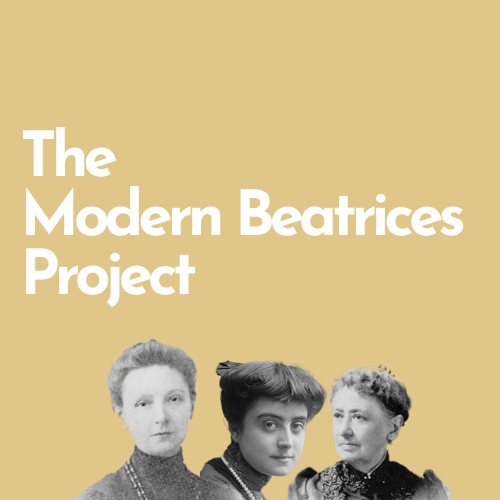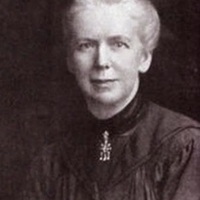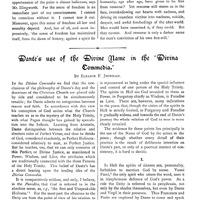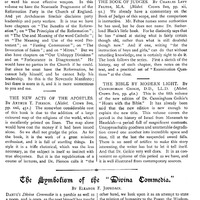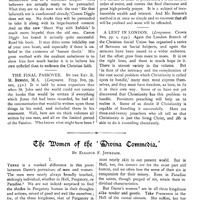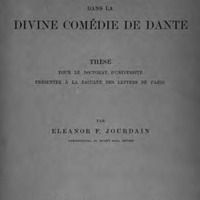Person
Jourdain, Eleonor Frances (1863-1924)
- Title
- Eleonor Frances Jourdain
- Lifespan
- 1863-1924
- Occupation
- College Head
- Scholar
- Campaigner for women's education
- Member of the London Dante Society
- Public Lecturer
- Periodical contributor
- The Expository Times
- Short biography
- Early Life
- Eleonor Frances Jourdain was born in Ashbourne, Derbyshire on 16 November 1863, her father was Francis Jourdain (1834–1898), a vicar and her mother, Emily, was the daughter of Charles Clay. Jourdain was the first of ten children. There were at least two sisters: Charlotte, who had been one of St Hugh's College's first four students, and Margaret, a writer on English furniture and decoration. Her brother Philip Jourdain was a prolific editor for The Monist.
- Education
- Educated at first at home, she played her part in educating, and later supporting, the younger children (the two youngest were partially paralysed by multiple sclerosis). Between the ages of fourteen and eighteen she attended a private day school in Manchester, financed by her mother's parents, who also enabled her to go to Lady Margaret Hall, Oxford, as a scholar in 1883. Her father, though by some accounts no enthusiast for women's education, nevertheless supported the opening of Oxford undergraduate examinations to women, and three Jourdain daughters studied at Oxford. Eleanor was in 1886 one of the first women examined in the modern history school and the first woman to undergo a viva. She was placed in the second class.
- Career
- After a brief period as secretary to Minnie Benson, wife of the archbishop of Canterbury and mother of a contemporary at Lady Margaret Hall, she became an assistant mistress, first at Tottenham high school and then at Clifton high school. In 1892 the Clifton headmistress, Miss M. A. Woods, joined her in founding Corran Collegiate School, Watford, a private boarding- and day school offering 'a thorough education of the best type for girls of all ages', where Miss Jourdain was soon sole headmistress. She proved to be, in the words of one former pupil, 'a born teacher' (Evans, Prelude and Fugue, 35). The success of this school, which had by 1900 more than 100 pupils, launched her on the next phase of her career.
-
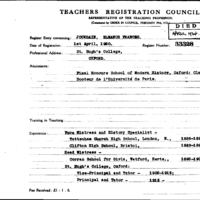 Eleonor Jourdain, Union card
Eleonor Jourdain, Union card
-
Jourdain left in 1903 and moved to Paris and spent a year studying the symbolism in Dante's Divine Comedy. She published articles in both French and English on her research and was awarded a doctorate in 1904 from the University of Paris based on her research. In Paris she rented a Rive Gauche flat—270 boulevard Raspail—in partnership with the daughter of a Sorbonne professor who had been on the Corran staff, where older girls could spend a year studying. There Miss Jourdain spent vacations between 1900 and 1914.
In Paris, Jourdain was chiefly famous for claiming that she and Moberly had slipped back in time to the period of the French Revolution while on a trip to Versailles, known as the Moberly–Jourdain incident. Their book was published pseudonymously; their identity was not revealed until the mid-1920s, after Jourdain's death. The book was a best seller but the claims drew a sceptical response by many. -
She was then invited by Charlotte Anne Elizabeth Moberly, who was acting principal of St Hugh's Hall to come to St Hugh's as vice principal.
In 1905, she began tutoring French at St Hugh's and serving as vice principal. Beginning at around 1908, she was a leader in the suffrage movement for St Hugh's, often attending demonstrations in London in her doctoral robes. She also continued to publish and presented such works as 'Methods of moral instruction and training of girls in France' in Moral Instruction and Training in Schools, edited by M. E. Sadler (1908, 2.85–112); On the Theory of the Infinite in Modern Thought (1911), An Introduction to the French Classical Drama (1912). In April 1915, she replaced Moberly as principal at St. Hugh's and during World War I accepted a position to work as a translator for the government. Beginning in 1920, she lectured in French at Oxford, becoming one of the first women to hold university lectures.
She was among the first women to hold university lecturerships at Oxford, as Taylorian lecturer in French, 1920–22, and in 1922 was the first woman to examine undergraduates in the schools. At the peak of her career she was president (1921–2) of the Modern Language Association. At the time of her death she was working on a history of Burgundy.
In 1922, she became the first woman to conduct undergraduate examinations.
Jourdain was an autocratic leader and in November 1923, she persuaded the college council to fire a tutor, Cecilia Mary Ady, whom she thought was challenging her authority. Ady protested her wrongful termination causing all the tutors and several council members to resign, as well as resulting in boycotts by tutors at other Oxford affiliated schools. The ensuing situation was widely reported in the press and an investigation, initially welcomed by Jourdain, was undertaken. - Janet Howarth, Jourdain, Eleanor Frances OXDNB entry
- The work on Dante
-
Jourdain began her Dante studies, publishing extensively in periodicals. It was during her summer holidays in Paris that she had the chance to pursue her research and further her investigation into the symbolism in Dante’s Divina Commedia: a project that was first published in English (1902) and in French (1903), for which she was in 1904 awarded a doctorate by the University of Paris, Sorbonne.
The string of periodical publications was largely written for the Expository Times, an academic journal specialized in biblical and theological scholarship, starting with “The Symbolism of the Divina Commedia” (1 November 1894), followed by “Dante’s Use of the Divine Name in the Divina Commedia” (1 April 1895) and “The Women of the Divina Commedia” (1 July 1895).
Excluded from the Oxford Dante Society, whose statute did not accept female members, Jourdain took an active part in the life of the London Society as lecturer and Member of the Council. As lecturer, she delivered two papers a decade apart: the first, titled “Some Aspects of the Symbolism of the Divina Commedia”, reframed from her doctoral thesis and published articles on the same subject; the second, in 1913 explored an entirely different subject, “The Mysticism of Dante and Pascal” with the Archdeacon of London as chair. - When it became evident that she would be asked to resign, Jourdain suffered a heart attack and died on 6 April 1924. She was buried in Wolvercote Cemetery, Oxford.
- Selected List of Publications
- (1894). The symbolism of the Divina commedia. New York. Christian literature.
- (1895). Dante's use of the divine name in the "Divina commedia". New York. Christian literature.
- (1895). The women of the ""Divina commedia"". New York: Christian literature.
- (1902). A study in the symbolism of the ""Divina commedia"". Shaldon, South Devon. E.E. Speight.
-
 A study in the symbolism of the Divina commedia
A study in the symbolism of the Divina commedia
- (1903). Le symbolisme dans la Divine comédie de Dante (Thése). Paris: A. Picard & fils.
- (1911). On the theory of the infinite in modern thought: two introductory studies. London: Longmans, Green and Co.
- with Moberly, C. A. E. (1911). An Adventure [at the Petit Trianon. Signed Elizabeth Morison, Frances Lamont. London.
- Relation
-
 Anglophone women writers
Anglophone women writers
- Link to external sources
- R. Tricket (1986). ‘The row’, St Hugh's: one hundred years of women's education in Oxford.
- L. Scwartz (2011). A Serious Endeavour Gender, Education and Community at St Hugh's, 1886-2011. London. Profile Books
- F. Camilletti ed. (2021) Il sogno della regina in rosso di A. Moberly e E. Jourdain. ABEditore
Linked resources
- Resource class
- Person
Ashbourne CP, Compton, Derbyshire Dales, Derbyshire, Inghilterra, Regno Unito
Oxford, Oxfordshire, Inghilterra, Regno Unito
Oxford, Oxfordshire, Inghilterra, Regno Unito
- Media
-
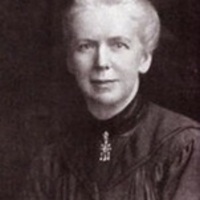 Eleonor Frances Jourdain
Eleonor Frances Jourdain
Part of Jourdain, Eleonor Frances (1863-1924)
Annotations
There are no annotations for this resource.
Position: 5 (262 views)
